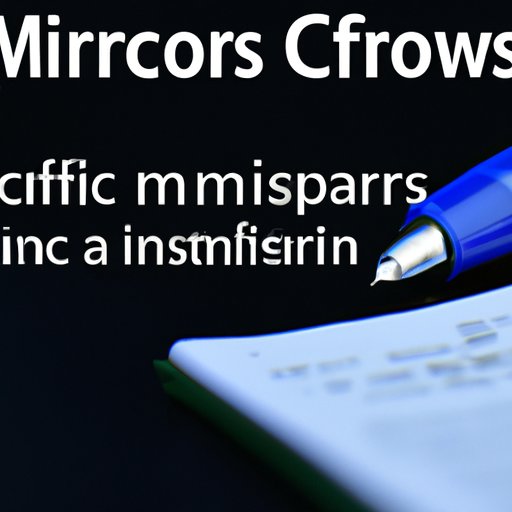How to Make a Table of Contents in Word: A Step-by-Step Guide
If you’ve ever had to navigate through a long document or manuscript, you know how useful a table of contents can be. It serves as a roadmap, helping readers quickly find the information they need. A table of contents is also a great way to organize your document and make it easier to write and edit. In this article, we’ll cover everything you need to know to create a table of contents in Microsoft Word.
Step-by-Step Tutorial
The first step is to create headings for all the content areas in your document. This can be done by highlighting the text you want to use as a heading, then selecting “Heading 1” from the “Styles” menu. You can add subheadings by selecting the text and choosing “Heading 2” or “Heading 3”, depending on the complexity of your document.
To insert the table of contents, you’ll need to place your cursor where you want to insert it. Typically, the table of contents goes at the beginning of a document, but it can also be placed elsewhere if that’s more convenient. After you’ve set the cursor, click on the “References” tab and select “Table of Contents”. Choose the design that best fits your document by clicking on the option you prefer. At this point, your table of contents has been created!
Customization is key when it comes to creating a table of contents in Microsoft Word. You can either do this while creating the table or once it’s been generated. To modify your table, click on “Table of Contents” in the “References” tab. From here you can choose to modify various aspects of the design including font, size, and indentation. Any changes you make will be automatically saved to your document.
Video Tutorial
If you’re more visual or prefer to learn through demonstration, we’ve got you covered with a video tutorial. You can find it below:
The video tutorial covers everything in the step-by-step guide and provides additional insights for those who need more help. Additionally, the video goes over some useful shortcuts and tricks.
Tips and Tricks
The process of making a table of contents can be daunting, especially if you’re dealing with a long document. There are some tips and tricks to help you stay organized and streamline the process.
If you break down the process into smaller, more manageable steps, you’ll find that creating a table of contents is much easier. Start with creating your headings and subheadings, and then decide where in the document the table of contents will be placed. This will help you stay organized and save time.
Another trick is to make use of Word’s tools. Features like “Outline View” can be incredibly useful when organizing the content of a document. This can easily be accessed by clicking on the “View” tab and then selecting “Outline”. Here, you can reorganize your headings, review content, and edit text without having to jump back and forth throughout the document.
Using Available Tools
Word includes a feature that makes creating a table of contents a breeze. This feature generates a pre-formatted table of contents based on the headings in your document and is very customizable, so it’s great for documents of all sizes. To use the feature, simply select the “References” tab and then click on “Table of Contents”. Choose the design you want and then click “OK” to generate your table. The feature will ensure that it’s always updated to the latest version of the document.
Customizing Your Table of Contents
By default, Word’s table of contents are automatically generated based on your document’s headings. However, you may want to create a custom table of contents to make it more effective or to better match the style of your document. Customizing your table of contents takes just a few steps, but to save time, it’s best to do it before inserting your table.
To customize your table, go into the “Table of Contents Gallery” by selecting the “References” tab. From here, click on “Custom Table of Contents”. You will then see a menu with options to change the font, size, and style of your table. You can also choose whether or not to include page numbers or dotted leader lines, and whether the titles should be hyperlinked.
Once you’re done making changes to your table of contents, click “OK” to apply your changes. If you have already inserted your table of contents, Word will prompt you to update the table and apply your changes.
Common Problems and Solutions
Even with the best planning, creating a table of contents can sometimes be frustrating. Here are some common issues and solutions:
1. Incomplete or missing headings – Make sure all the headings are included. If your headings are cut off, try increasing the font size or moving the heading to a new page.
2. Incorrect page numbers – Remember to update the table of contents each time you make significant changes to your document.
3. Formatting Issues – Be sure to use the same style across the entire document. If the formatting still appears off, go to “Styles” in the “Home” tab and manually adjust the headers.
Conclusion
A table of contents is one of the most essential tools for any long document or manuscript, and creating one is easier than you may think. By using the step-by-step instructions outlined in this article, along with the tips and tricks provided, you should find yourself creating effective table of contents in no time. Mastering the creation of table of contents in Word is a great way to keep your documents organized and professional and will save you time in the long run.
